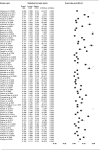Prevalence of Depression in the Community from 30 Countries between 1994 and 2014
- PMID: 29434331
- PMCID: PMC5809481
- DOI: 10.1038/s41598-018-21243-x
Prevalence of Depression in the Community from 30 Countries between 1994 and 2014
Erratum in
-
Author Correction: Prevalence of Depression in the Community from 30 Countries between 1994 and 2014.Sci Rep. 2022 Sep 1;12(1):14856. doi: 10.1038/s41598-022-19021-x. Sci Rep. 2022. PMID: 36050349 Free PMC article. No abstract available.
Abstract
The prevalence of depression may be affected by changes in psychiatric practices and the availability of online mental health information in the past two decades. This study aimed to evaluate the aggregate prevalence of depression in communities from different countries between 1994 and 2014 and to explore the variations in prevalence stratified by geographical, methodological and socio-economic factors. A total of 90 studies were identified and met the inclusion criteria (n = 1,112,573 adults) with 68 studies on single point prevalence, 9 studies on one-year prevalence, and 13 studies on lifetime prevalence of depression. A random-effects model meta-analysis that was performed to calculate the aggregate point, one-year and lifetime prevalence of depression calculated prevalences of 12.9%, 7.2% and 10.8% respectively. Point prevalence of depression was significantly higher in women (14.4%), countries with a medium human development index (HDI) (29.2%), studies published from 2004 to 2014 (15.4%) and when using self-reporting instruments (17.3%) to assess depression. Heterogeneity was identified by meta-regression and subgroup analysis, and response rate, percentage of women and year of publication, respectively, were determined contribute to depression prevalence. This meta-analysis allows benchmarking of the prevalence of depression during the era when online health information emerged, facilitating future comparisons.
Conflict of interest statement
The authors declare no competing interests.
Figures
References
Publication types
MeSH terms
LinkOut - more resources
Full Text Sources
Other Literature Sources
Medical
Miscellaneous





